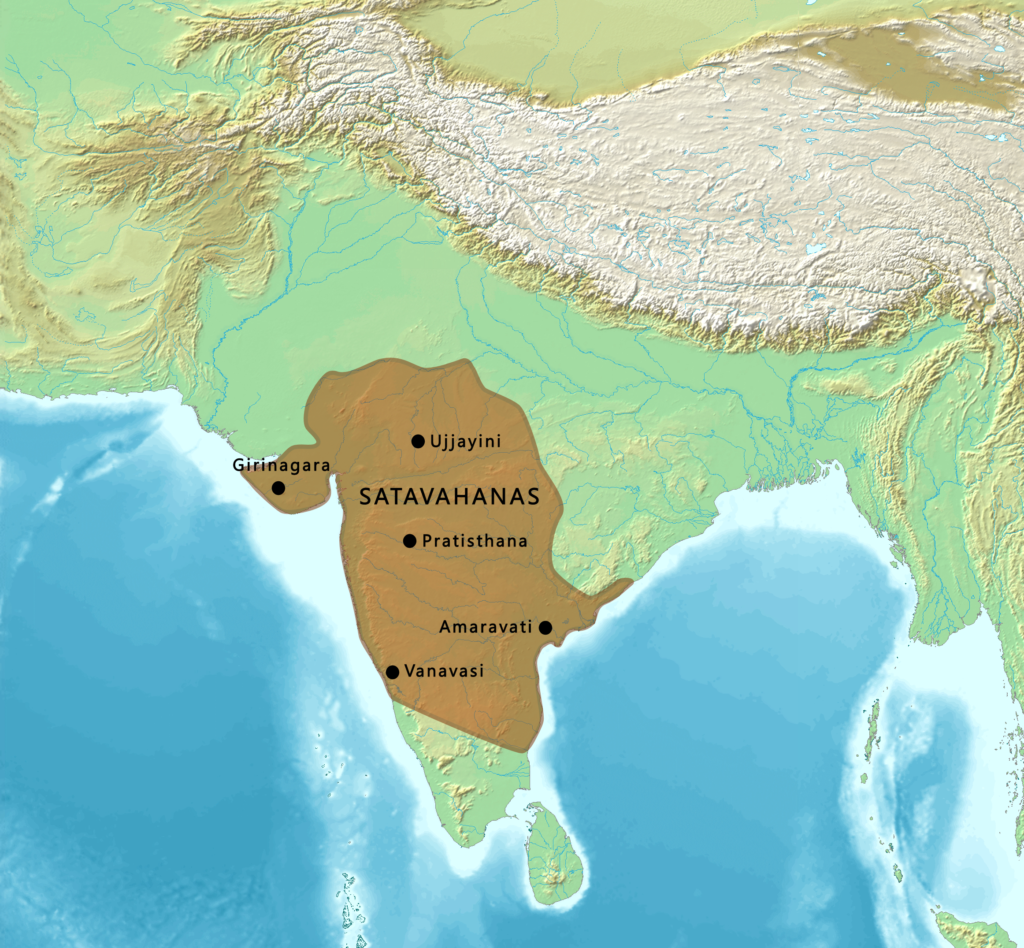After the downfall of the mighty Mauryan Empire, several new kingdoms emerged. While many of us have heard the name of the Sungas (which ruled mostly in the northern part of the subcontinent) we often forget to mention the kingdom which ruled the southern part of the subcontinent during the post-Mauryan Era.

The Satavahanas or the Andhras emerged as a powerful kingdom in the Deccan region after the fragmentation of the Mauryan Empire.
They are famously known as the Lord of the Dakshinapatha (Dakshinapathapati). This great dynasty dominated the region around Deccan and southern India.
In this article, we will shed light on the magnificent career of Gautamiputra Satakarni who is considered the greatest king of this dynasty. He is known by many names such as Dakshinapathapati, Maharaja and the list goes on.
Content
Early Kings of Satavahanas
The great Satavahanas controlled the region of modern Deccan with the capital at Pratishthana.
According to several inscriptions, the Satavahanas were mentioned as the Andhra or Andhrabhritya (servants of the Andhra).
It is also believed that their ancestors were part of the great Mauryan Empire. Furthermore, all the information or most of the information about early Satavahana kings is mentioned in the Puranas.

The first ruler of this dynasty is known as Simuka who is believed to have ruled for about 23 years. According to the Puranic evidence, this king had defeated the Kanva dynasty and the remnants of the Sunga Empire.
Later Simuka was succeeded by his brother Krishna who ruled for 18 years, Krishna’s son Satakarni I also ruled for 18 years both these rulers are known from inscriptions. According to the Hathigumpha inscription the boundaries of Satakarni I touched the region of Kalinga, northern Konkan, and also Saurashtra.
Dark Period of the Satavahanas
The period between the reign of Satakarni 1 and that of Gautamiputra Satakarni is considered a dark phase or temporary eclipse of the Satavahana power.
This is due to the gradual rise of Shakas (Scythians/ Shaka Kshatrapas of Western India) which defeated and conquered the territories of north Maharashtra, Konkan, Malwa, Saurashtra, and southern Rajputana.
Both the Satavahanas and the Shaka Kshatrapas had a bitter rivalry that lasted for many years. Both sides desperately fought several titanic wars mainly for the control of seaports like Bhrigukachcha, Kalyan, and Sopara.
Rise of Gautamiputra Satakarni
Gautamiputra Satakarni was the greatest king of the mighty Satavahana dynasty. He decimated the Kshaharata lineage of the Western Shakas. He ended the dominance of the Shakas and regained the lost prestige of the Satavahanas.
However, the exact date of his reign is a little ambiguous. But historians had suggested the date of his rule was roughly from 106-30 CE.
According to ancient texts, he is described as a powerful and fearless monarch who was very obedient toward his mother.
Due to his several achievements, he is given various names and epithets such as Vara-Varana-Vikrama-Charu Vikrama (one whose gait is as beautiful as that of the choice elephant). He is also described as the Lord of the Vindhyas.
Mentioned as the destroyer of the Scythians, Indo-Greeks, and Parthians (Saka-Yavana-pahlavanisudana) and the establisher of the fame of the family of Satavahana (Satavahana kula yasah pratishthapana kara).
A lot of information about Gautamiputra Satakarni is provided by the famous Nasik inscription. All his conquests and his rapid territorial expansion are mentioned in this inscription.
According to the Nasik inscription, Gautamiputra Satakarni retook the territories of upper Deccan, western and central India. The inscription further tells us that the king also granted some portion of land to the Shakas.
Due to this notable success against the powerful enemies, he adopted the title of Rajaraja and Maharaja.
Furthermore, he is also mentioned as the uprooter of the Shakas, Phalavas, and the yavanas and described as Ekabamhana i.e. a peerless brahmana, and khatiya-dapa-manamada i.e. one who destroyed the high-handedness and pride of the Kshatriyas.
Note: Gautamiputra also performed two Aswamedha yagnas.
It was during his reign that the Satavahana territorial boundary reached its zenith. The region of Saurashtra, Avanti, Mulaka, Vidarbha (Berar), etc. was also absorbed into the empire of Gautamiputra Satakarni.
Apart from all this, the Satavahana king was also religiously tolerant towards other religions. It is believed that the Satavahana kings started the practice of granting land to Buddhist and Brahmin monks.
Furthermore, in one of the inscriptions, it is mentioned that the lands of Brahmans and Buddhist monks should never be disturbed by the royal troops.
All in all Gautamiputra Satakarni is the greatest ruler of the Satavahana dynasty. He achieved impossible things and took the Empire to new heights. He brought back the old prestige of this dynasty which got decimated by the repeated onslaughts of the Shakas.
Note: Before his death, he lost some of his territories from the Shakas of the Kardamaka dynasty. This fact is further supported by the Junagarh inscription of Rudradaman 150 AD.
Want to know more stories of Ancient India??
Read the story of king Samudragupta Here>>
Donate to our Cause
If you support what we are doing and would like to contribute to help us grow and reach more Indians to teach them more about such forgotten historic Indian Heroes and stories, please consider donating any amount. It will help us grow

